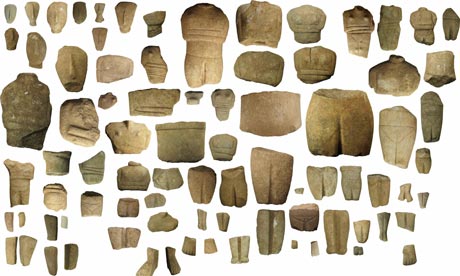Cambridge scientists dig up evidence of beautiful marble figurines broken then buried by Greeks 4,500 years ago.
To say it has been an archaeological mystery may be an understatement: why are fragments of beautiful but deliberately smashed bronze age figurines buried in shallow pits on a small, rocky Greek island whose main inhabitants have always been goats?
Today, academics at Cambridge University will release findings that shed light on the 4,500-year-old puzzle of Keros, a tiny Cycladic island in the Aegean.
It appears Keros was the ceremonial destination for a ritual that involved islanders breaking prized possessions and making a pilgrimage with fragments for burial.
"It is rather remarkable," said Professor Colin Renfrew, who led the most recent archaeology excavations.
"We believe that the breaking of statues and other goods was a ritual and that Keros was chosen as a sanctuary to preserve the effects."
The Keros story began in 1963 with Renfrew himself. Then a long-haired research student – he is now Lord Renfrew – he stepped off a caïque boat on to the island (human population: two goatherders) after being tipped off about a site of archaeological interest.
"I was amazed to find fragments of marble bowls and marble figurines," said Renfrew. The fragments were of a type of sculpture found across the Cyclades, examples of which can be seen in the British Museum and have inspired artists including Pablo Picasso, Constantin Brancusi and Henry Moore.
The Keros sculptures were almost all broken. Archaeologists found thousands of marble vessel fragments and hundreds of figurine body parts, such as a pair of thighs, a folded arm or an elongated foot.
The matter rested there until 1987 when Renfrew, by now the Disney professor of archaeology at Cambridge, returned to Keros to begin more serious archaeology excavation.
That led him to the discovery that the breakages were not the result of careless looting. "It became clear that this was a very strange site."
In 2006 Renfrew found an unlooted site of buried broken figurines and the remains of a settlement on an islet about 100 metres away, Dhaskalio.
There the team found evidence of a kind of bronze age guesthouse where visiting villagers would have congregated on their pilgrimage.
Geological examinations showed it was built from imported marble rather than the flaky local limestone.
The team had found – from around the same time the Pyramids were being built – evidence of huge amounts of marble being transported across the sea to build Dhaskalio.
Renfrew's theory is that Cycladic villagers would have used the figurines and bowls in a ritualistic way, perhaps carrying them in processions as icons are carried in Greek villages today.
"After they had been used for some time, perhaps decades, the time would come that it would go out of use," he said. So they were broken and fragments taken to "one remarkable ritual centre".
Renfrew said it was likely that the islanders would go to Keros at regular intervals, in much the same way that the ancient Greeks held the Olympics every four years.
"No doubt it was a ceremony of renewal – a new generation of icons being used and a new generation of people growing up."
The evidence suggests fragments were ritualistically deposited on Keros for about 400-500 years, until around 2000BC.
Renfrew said there were still many more puzzles at Keros and Dhaskalio to be answered. The latest research will be published as a basis for further investigations.
For more interesting topics related to archaeology, visit archaeology excavations.
Archaeology excavation is best known and most commonly used within the science of archaeology. In this sense it is the exposure, processing and recording of archaeological remains.
Thursday, June 9, 2011
Broken idols of Keros: British archaeologists explain Greek mystery
Subscribe to:
Post Comments (Atom)

No comments:
Post a Comment